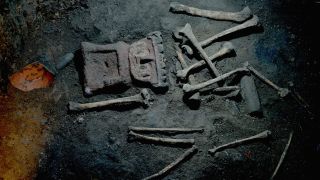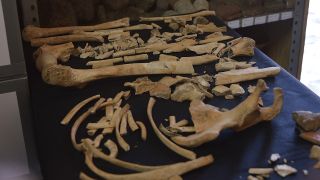16th-century ritual sacrifice, cannibalism and bloody slaughter revealed in Mexican city
Ritual sacrifice of captured Spaniards sparked a brutal and deadly reprisal.

In 1520, Indigenous people in Zultépec in what is now Mexico captured a Spanish caravan of about 450 people. Over the next eight months, they ritually sacrificed all of the captives and likely ate them, archaeologists recently discovered.
The Spanish retaliated viciously, with soldiers attacking the town and butchering hundreds in just one day. Spanish soldier Gonzalo de Sandoval led the attack under orders from Hernán Cortés, leader of Spain's invasion of Mexico, and the victims in Zultépec were mostly women and children, said researchers with Mexico's National Institute of Anthropology and History (INAH).
Many of the women and children were slaughtered while hiding in their homes or while trying to escape the carnage, INAH representatives said in a statement. Their findings represent more than three decades of work at the site where Zultépec once stood, revealing new details about the violent acts committed on both sides.
Related: Photos: The amazing pyramids of Teotihuacan
Zultépec's residents at the time were Acolhua, a Mesoamerican ethnic group and a sister culture to the Aztecs. Their captives from the caravan included European men, women and children; Maya, Tlaxcaltec and Totonac people who were Spanish allies; and Cuban people of African and Indigenous descent, Mexico News Daily reported. After the caravan's capture, the Acolhua sacrificed people to Xiuhtecuhtli according to dates on the Acolhua ritual calendar, the researchers said.
However, during the months when the caravan travelers were held captive, the Acolhuas modified their buildings to host the "foreigners," adding walls and European-style ovens, according to the statement. But these comforts were short-lived, and the last of the captives was sacrificed in January or February of 1521. Around this time, a hill near Zultépec became known locally as "Tecoaque," or "where they were eaten" in the Nahuatl language of central Mexico, suggesting that people in Zultépec ate the captives.

Zultépec's inhabitants likely knew the Spaniards would soon retaliate, archaeological evidence hints. For instance, the residents tried to fortify their city by building new walls that blocked access to residential neighborhoods. Acolhua people also seemingly tried to hide the bodies of the murdered captives; when researchers inspected 22 of the town's cisterns, they found human bones that had been carved into trophies, along with caravan prisoners' personal items, sculptures of Mesoamerican deities and remains of the caravan's pack animals.
Sign up for the Live Science daily newsletter now
Get the world’s most fascinating discoveries delivered straight to your inbox.
Sandoval and his men attacked in March of that year, site director Enrique Martínez Vargas said in the statement. On one stretch of road measuring about 390 feet (120 meters) long, archaeologists discovered a dozen skeletons of women who apparently died while protecting 10 children "between five and six years of age," Vargas said. The positions of their bodies "suggests that the people were in full flight," and were massacred and buried hastily where they fell, he said.
Women and children who tried to hide indoors "were in turn mutilated, as evidenced by the recovery of severed bones on the floor of the rooms," Vargas said in the statement. Conquistadors also burned Zultépec's temples and beheaded sculptures of the Acolhua gods. The brutality of the attack was intended as both revenge for the murdered prisoners and as a warning against future resistance to Spanish occupation and conquest, Vargas said.
Originally published on Live Science.

Mindy Weisberger is an editor at Scholastic and a former Live Science channel editor and senior writer. She has reported on general science, covering climate change, paleontology, biology, and space. Mindy studied film at Columbia University; prior to Live Science she produced, wrote and directed media for the American Museum of Natural History in New York City. Her videos about dinosaurs, astrophysics, biodiversity and evolution appear in museums and science centers worldwide, earning awards such as the CINE Golden Eagle and the Communicator Award of Excellence. Her writing has also appeared in Scientific American, The Washington Post and How It Works Magazine.
